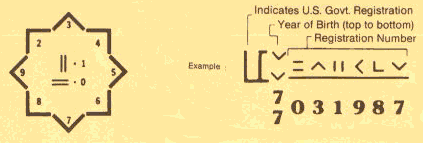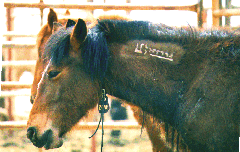
Since April of 1978, all mustangs and burros rounded up by BLM and the U.S. Forest Service have been identified with a unique, painless freeze-mark. The mark is put on the left side of the neck and is a series of right angles and straight lines that can't be destroyed or changed.

The freeze-mark was developed by Dr. Keith Farrell of Pullman, Washington, and was first used in Sweden around 1966. Aside from being painless and indestructible, it is readily visible, inexpensive, and easy to apply using one of two irons. A small iron is used to freeze-mark foals, and a larger one for adult mustangs and burros. The freeze-mark on the foals can increase in size by two-thirds when the foal is fully grown.
 The iron is placed in liquid nitrogen until it reaches a cold
minus-32O degrees Fahrenheit. The animal's hair is then clipped
as close to the skin as possible using standard animal clippers.
The area to be marked is thoroughly washed with alcohol, and the
iron is held to the skin of dark horses for 10-20 seconds, and
to the skin of light horses for 40-50 seconds. After 30-60 days,
the hair on the dark colored horses will grow back white. On
light colored animals, the hide turns dark.
The iron is placed in liquid nitrogen until it reaches a cold
minus-32O degrees Fahrenheit. The animal's hair is then clipped
as close to the skin as possible using standard animal clippers.
The area to be marked is thoroughly washed with alcohol, and the
iron is held to the skin of dark horses for 10-20 seconds, and
to the skin of light horses for 40-50 seconds. After 30-60 days,
the hair on the dark colored horses will grow back white. On
light colored animals, the hide turns dark.
Each state where mustangs and burros are located is assigned a series of numbers unique to the animals within that state. After an animal is freeze-marked, the number is recorded and maintained indefinitely in BLM's central computer data base in Denver, Colorado. The information is available in each of the BLM offices across the country through the computer terminal. Each freeze-mark is tied to about 100 categories of information in the computer data base, ranging from the capture area, to the adopter's address.

